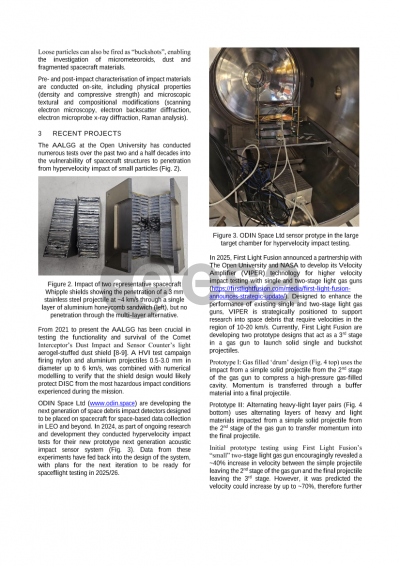Document details

Abstract
Introduction
Micrometeoroid and space debris (MMSD) particles present a significant risk to operational spacecraft and to the long-term sustainability of space activities. Small micrometre sized particles can be capable of degrading spacecraft surfaces, whereas mm to cm-sized particles can perforate spacecraft structures, or puncture pressure vessels, leading to the damage or destruction of components or whole spacecraft. Consequently, research into spacecraft protection and active debris avoidance, mitigation and recovery have become increasingly topical in recent years.
Light gas guns (LGGs) are powerful experimental tools that have become essential in the study of MMSD impacts to ground test numerical simulations of collisions in a controlled and observable environment. The Open University’s Hypervelocity Impact Laboratory (HVI Lab) houses a 5.7 m long 4.5 mm (0.177” calibre) bore All-Axis Light Gas Gun (AALGG). For more than two decades, the AALGG has been used for a variety of hypervelocity impact simulations, for astrobiology, planetary defence, and space exploration optimisation (material endurance and calibration). This paper presents the OU’s HVI Lab as a facility for available for upcoming MMSD research.
AALGG Functional and Diagnostic capabilities
The AALGG has the distinctive ability to rotate between horizontal and (downwards) vertical firing, facilitated by a purpose-built retractable floor and hand driven gearbox, which enables a range of impact angles and the use of loosely consolidated targets.
Two target chamber sizes are available for use: a smaller 200 mm diameter chamber (horizontal & vertical orientations); and a larger 0.9 m diameter and 2.0 m long cylindrical chamber (vertical orientation only) to accommodate larger targets, each equipped with viewports, and electrical feedthroughs for in-situ diagnostics. High-speed cameras, including a Photron FASTCAM SA-Z record high-resolution (>1M frames per second) videos of impacts. Further in situ assessments include analysing the outgassed volatile headspace from impacts using a quadrupole mass spectrometer; developing debris cloud tracking using shadow laser photography; and measuring the thermal profile of an impact flash using a high-speed pyrometer. Crucially for space debris applications we aim to collect ejected material in aerogel or foam witness plates to characterise the fragmentation of spacecraft materials into ejected debris clouds.
The AALGG can accelerate spherical/cylindrical projectiles of up to 4.5 mm diameter up to 6 km/s, with aims to reach faster velocities with current developments. Loose particles can also be fired as “buckshots”, enabling the investigation of micrometeoroids, dust and fragmented spacecraft materials.
Pre- and post-impact characterisation of impact materials are conducted on-site, including physical properties (density and compressive strength) and microscopic textural and compositional modifications (scanning electron microscopy, electron backscatter diffraction, electron microprobe x-ray diffraction, Raman analysis).
Recent Projects
From 2021 to present the AALGG has been crucial in testing the functionality and survival of the Comet Interceptor’s Dust Impact and Sensor Counter, and this year we have conducted experiments for ODIN Space testing their acoustic impact sensors for their space-based data collection systems. In addition, numerous experimental campaigns have been conducted into the vulnerability of spacecraft structures to penetration from hypervelocity impact of small particles. Future experiments plan to investigate the impact dynamics and fragmentation behaviours of spacecraft CCDs and the vulnerability of spacecraft through impact focusing of x-ray gratings and Whipple shield spallation.
Conclusions
The Open University’s HVI Lab facility aims to partake in more collaborative projects to address significant knowledge gaps that remain to understand the impact dynamics, debris fragmentation, material behaviours and long-term debris evolution in the near-Earth environment. Furthermore, the facility is taking steps to improve its functional and diagnostic capabilities to address known experimental limitations.
Preview





